公司理财精要第十版(全)PPT
- 格式:ppt
- 大小:452.50 KB
- 文档页数:17
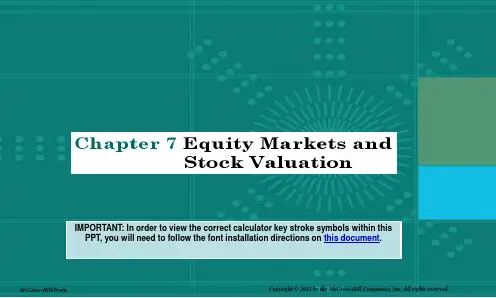
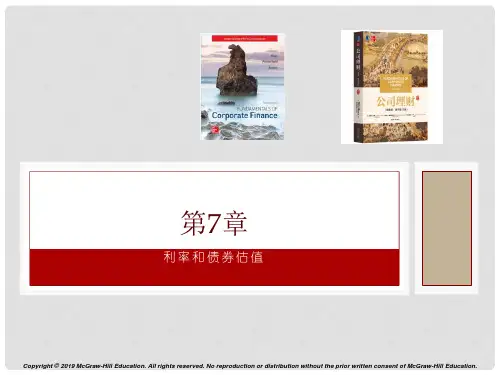


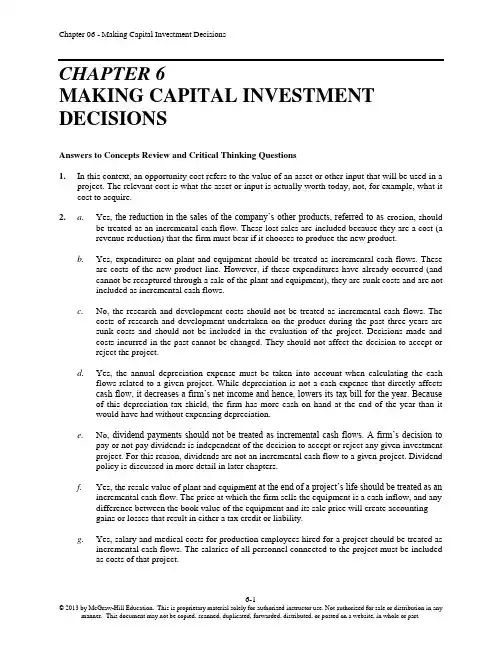
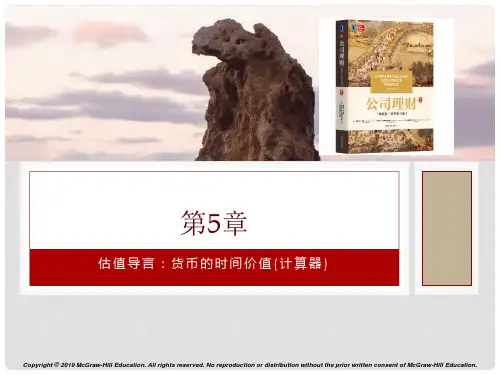
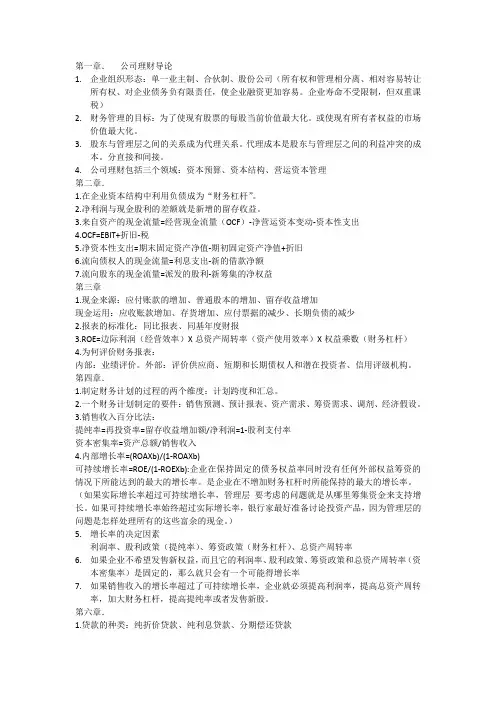
第一章.公司理财导论1.企业组织形态:单一业主制、合伙制、股份公司(所有权和管理相分离、相对容易转让所有权、对企业债务负有限责任,使企业融资更加容易。
企业寿命不受限制,但双重课税)2.财务管理的目标:为了使现有股票的每股当前价值最大化。
或使现有所有者权益的市场价值最大化。
3.股东与管理层之间的关系成为代理关系。
代理成本是股东与管理层之间的利益冲突的成本。
分直接和间接。
4.公司理财包括三个领域:资本预算、资本结构、营运资本管理第二章.1.在企业资本结构中利用负债成为“财务杠杆”。
2.净利润与现金股利的差额就是新增的留存收益。
3.来自资产的现金流量=经营现金流量(OCF)-净营运资本变动-资本性支出4.OCF=EBIT+折旧-税5.净资本性支出=期末固定资产净值-期初固定资产净值+折旧6.流向债权人的现金流量=利息支出-新的借款净额7.流向股东的现金流量=派发的股利-新筹集的净权益第三章1.现金来源:应付账款的增加、普通股本的增加、留存收益增加现金运用:应收账款增加、存货增加、应付票据的减少、长期负债的减少2.报表的标准化:同比报表、同基年度财报3.ROE=边际利润(经营效率)X总资产周转率(资产使用效率)X权益乘数(财务杠杆)4.为何评价财务报表:内部:业绩评价。
外部:评价供应商、短期和长期债权人和潜在投资者、信用评级机构。
第四章.1.制定财务计划的过程的两个维度:计划跨度和汇总。
2.一个财务计划制定的要件:销售预测、预计报表、资产需求、筹资需求、调剂、经济假设。
3.销售收入百分比法:提纯率=再投资率=留存收益增加额/净利润=1-股利支付率资本密集率=资产总额/销售收入4.内部增长率=(ROAXb)/(1-ROAXb)可持续增长率=ROE/(1-ROEXb):企业在保持固定的债务权益率同时没有任何外部权益筹资的情况下所能达到的最大的增长率。
是企业在不增加财务杠杆时所能保持的最大的增长率。
(如果实际增长率超过可持续增长率,管理层要考虑的问题就是从哪里筹集资金来支持增长。
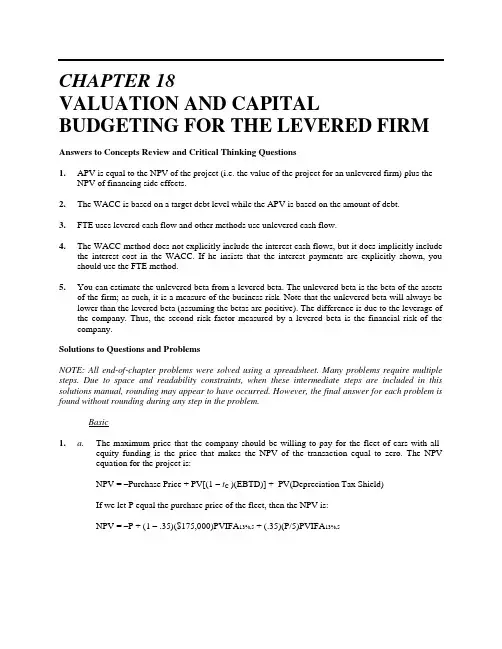
CHAPTER 18VALUATION AND CAPITAL BUDGETING FOR THE LEVERED FIRM Answers to Concepts Review and Critical Thinking Questions1.APV is equal to the NPV of the project (i.e. the value of the project for an unlevered firm) plus theNPV of financing side effects.2. The WACC is based on a target debt level while the APV is based on the amount of debt.3.FTE uses levered cash flow and other methods use unlevered cash flow.4.The WACC method does not explicitly include the interest cash flows, but it does implicitly includethe interest cost in the WACC. If he insists that the interest payments are explicitly shown, you should use the FTE method.5. You can estimate the unlevered beta from a levered beta. The unlevered beta is the beta of the assetsof the firm; as such, it is a measure of the business risk. Note that the unlevered beta will always be lower than the levered beta (assuming the betas are positive). The difference is due to the leverage of the company. Thus, the second risk factor measured by a levered beta is the financial risk of the company.Solutions to Questions and ProblemsNOTE: All end-of-chapter problems were solved using a spreadsheet. Many problems require multiple steps. Due to space and readability constraints, when these intermediate steps are included in this solutions manual, rounding may appear to have occurred. However, the final answer for each problem is found without rounding during any step in the problem.Basic1. a.The maximum price that the company should be willing to pay for the fleet of cars with all-equity funding is the price that makes the NPV of the transaction equal to zero. The NPV equation for the project is:NPV = –Purchase Price + PV[(1 –t C )(EBTD)] + PV(Depreciation Tax Shield)If we let P equal the purchase price of the fleet, then the NPV is:NPV = –P + (1 – .35)($175,000)PVIFA13%,5 + (.35)(P/5)PVIFA13%,5Setting the NPV equal to zero and solving for the purchase price, we find:0 = –P + (1 – .35)($175,000)PVIFA13%,5 + (.35)(P/5)PVIFA13%,5P = $400,085.06 + (P)(.35/5)PVIFA13%,5P = $400,085.06 + .2462P.7538P = $400,085.06P = $530,761.93b.The adjusted present value (APV) of a project equals the net present value of the project if itwere funded completely by equity plus the net present value of any financing side effects. In this case, the NPV of financing side effects equals the after-tax present value of the cash flows resulting from the firm’s debt, so:APV = NPV(All-Equity) + NPV(Financing Side Effects)So, the NPV of each part of the APV equation is:NPV(All-Equity)NPV = –Purchase Price + PV[(1 – t C )(EBTD)] + PV(Depreciation Tax Shield)The company paid $480,000 for the fleet of cars. Because this fleet will be fully depreciated over five years using the straight-line method, annual depreciation expense equals:Depreciation = $480,000/5Depreciation = $96,000So, the NPV of an all-equity project is:NPV = –$480,000 + (1 – .35)($175,000)PVIFA13%,5 + (.35)($96,000)PVIFA13%,5NPV = $38,264.03NPV(Financing Side Effects)The net present value of financing side effects equals the after-tax present value of cash flows resulting from the firm’s debt, so:NPV = Proceeds – Aftertax PV(Interest Payments) – PV(Principal Payments)Given a known level of debt, debt cash flows should be discounted at the pre-tax cost of debt R B. So, the NPV of the financing side effects are:NPV = $390,000 – (1 – .35)(.08)($390,000)PVIFA8%,5– $390,000/1.085NPV = $43,600.39So, the APV of the project is:APV = NPV(All-Equity) + NPV(Financing Side Effects)APV = $38,264.03 + 43,600.39APV = $81,864.422.The adjusted present value (APV) of a project equals the net present value of the project if it werefunded completely by equity plus the net present value of any financing side effects. In this case, the NPV of financing side effects equals the after-tax present value of the cash flows resulting from the firm’s debt, so:APV = NPV(All-Equity) + NPV(Financing Side Effects)So, the NPV of each part of the APV equation is:NPV(All-Equity)NPV = –Purchase Price + PV[(1 –t C)(EBTD)] + PV(Depreciation Tax Shield)Since the initial investment of $1.7 million will be fully depreciated over four years using thestraight-line method, annual depreciation expense is:Depreciation = $1,700,000/4Depreciation = $425,000NPV = –$1,700,000 + (1 – .30)($595,000)PVIFA13%,4 + (.30)($425,000)PVIFA9.5%,4NPV (All-equity) = –$52,561.35NPV(Financing Side Effects)The net present value of financing side effects equals the aftertax present value of cash flowsresulting from the firm’s debt. So, the NPV of the financing side effects are:NPV = Proceeds(Net of flotation) – Aftertax PV(Interest Payments) – PV(Principal Payments) + PV(Flotation Cost Tax Shield)Given a known level of debt, debt cash flows should be discounted at the pre-tax cost of debt, R B.Since the flotation costs will be amortized over the life of the loan, the annual flotation costs that will be expensed each year are:Annual flotation expense = $45,000/4Annual flotation expense = $11,250NPV = ($1,700,000 – 45,000) – (1 – .30)(.095)($1,700,000)PVIFA9.5%,4– $1,700,000/1.0954 + .30($11,250) PVIFA9.5%,4NPV = $121,072.23So, the APV of the project is:APV = NPV(All-Equity) + NPV(Financing Side Effects)APV = –$52,561.35 + 121,072.23APV = $68,510.883. a.In order to value a firm’s equity using the flow-to-equity approach, discount the cash flowsavailable to equity holders at the cost of the firm’s levered equity. The cash flows to equity holders will be the firm’s net income. Remembering that the company has three stores, we find:Sales $3,900,000COGS 2,010,000G & A costs 1,215,000Interest 123,000EBT $ 552,000Taxes 220,800NI $ 331,200Since this cash flow will remain the same forever, the present value of cash flows available tothe firm’s equity holders is a perpetuity. We can discount at the levered cost of equity, so, thevalue of the company’s equity is:PV(Flow-to-equity) = $331,200 / .19PV(Flow-to-equity) = $1,743,157.89b.The value of a firm is equal to the sum of the market values of its debt and equity, or:V L = B + SWe calculated the value of the company’s equity in part a, so now we need to calculate the value of debt. The company has a debt-to-equity ratio of .40, which can be written algebraically as:B / S = .40We can substitute the value of equity and solve for the value of debt, doing so, we find:B / $1,743,157.89 = .40B = $697,263.16So, the value of the company is:V = $1,743,157.89 + 697,263.16V = $2,440,421.054. a.In order to determine the cost of the firm’s debt, we need to find the yield to maturity on itscurrent bonds. With semiannual coupon payments, the yield to maturity of the company’s bonds is:$1,080 = $35 (PVIFA R%,40) + $1,000(PVIF R%,40)R = .03145, or 3.145%Since the coupon payments are semiannual, the YTM on the bonds is:YTM = 3.145%× 2YTM = 6.29%b.We can use the Capital Asset Pricing Model to find the return on unlevered equity. Accordingto the Capital Asset Pricing Model:R0 = R F+ βUnlevered(R M–R F)R0 = 4% + .85(11% – 4%)R0 = 9.95%Now we can find the cost of levered equity. According to Modigliani-Miller Proposition II with corporate taxesR S = R0 + (B/S)(R0–R B)(1 –t C)R S = .0995 + (.40)(.0995 – .0629)(1 – .34)R S = .1092, or 10.92%c.In a world with corporate taxes, a firm’s weighted average cost of capital is equal to:R WACC = [B / (B + S)](1 –t C)R B + [S / (B + S)]R SThe problem does not provide either the debt-value ratio or equity-value ratio. However, the firm’s debt-equity ratio is:B/S = .40Solving for B:B = .4SSubstituting this in the debt-value ratio, we get:B/V = .4S / (.4S + S)B/V = .4 / 1.4B/V = .29And the equity-value ratio is one minus the debt-value ratio, or:S/V = 1 – .29S/V = .71So, the WACC for the company is:R WACC = .29(1 – .34)(.0629) + .71(.1092)R WACC = .0898, or 8.98%5. a.The equity beta of a firm financed entirely by equity is equal to its unlevered beta. Since eachfirm has an unlevered beta of 1.10, we can find the equity beta for each. Doing so, we find:North PoleβEquity = [1 + (1 –t C)(B/S)]βUnleveredβEquity = [1 + (1 – .35)($2,900,000/$3,800,000](1.10)βEquity = 1.65South PoleβEquity = [1 + (1 –t C)(B/S)]βUnleveredβEquity = [1 + (1 – .35)($3,800,000/$2,900,000](1.10)βEquity = 2.04b.We can use the Capital Asset Pricing Model to find the required return on each firm’s equity.Doing so, we find:North Pole:R S = R F+ βEquity(R M–R F)R S = 3.20% + 1.65(10.90% – 3.20%)R S = 15.87%South Pole:R S = R F+ βEquity(R M–R F)R S = 3.20% + 2.04(10.90% – 3.20%)R S = 18.88%6. a.If flotation costs are not taken into account, the net present value of a loan equals:NPV Loan = Gross Proceeds – Aftertax present value of interest and principal paymentsNPV Loan = $5,850,000 – .08($5,850,000)(1 – .40)PVIFA8%,10– $5,850,000/1.0810NPV Loan = $1,256,127.24b.The flotation costs of the loan will be:Flotation costs = $5,850,000(.025)Flotation costs = $146,250So, the annual flotation expense will be:Annual flotation expense = $146,250 / 10Annual flotation expense = $14,625If flotation costs are taken into account, the net present value of a loan equals:NPV Loan = Proceeds net of flotation costs – Aftertax present value of interest and principalpayments + Present value of the flotation cost tax shieldNPV Loan = ($5,850,000 – 146,250) – .08($5,850,000)(1 – .40)(PVIFA8%,10)– $5,850,000/1.0810 + $14,625(.40)(PVIFA8%,10)NPV Loan = $1,149,131.217.First we need to find the aftertax value of the revenues minus expenses. The aftertax value is:Aftertax revenue = $3,200,000(1 – .40)Aftertax revenue = $1,920,000Next, we need to find the depreciation tax shield. The depreciation tax shield each year is:Depreciation tax shield = Depreciation(t C)Depreciation tax shield = ($11,400,000 / 6)(.40)Depreciation tax shield = $760,000Now we can find the NPV of the project, which is:NPV = Initial cost + PV of depreciation tax shield + PV of aftertax revenueTo find the present value of the depreciation tax shield, we should discount at the risk-free rate, and we need to discount the aftertax revenues at the cost of equity, so:NPV = –$11,400,000 + $760,000(PVIFA3.5%,6) + $1,920,000(PVIFA11%,6)NPV = $772,332.978.Whether the company issues stock or issues equity to finance the project is irrelevant. Thecompany’s optimal capital structure determines the WACC. In a world with corporate taxes, a firm’s weighted average cost of capital equals:R WACC = [B / (B + S)](1 –t C)R B + [S / (B + S)]R SR WACC = .80(1 – .34)(.069) + .20(.1080)R WACC = .0580, or 5.80%Now we can use the weighted average cost of capital to discount NEC’s unlevered cash flows. Doing so, we find the NPV of the project is:NPV = –$45,000,000 + $3,100,000 / .0580NPV = $8,418,803.429. a.The company has a capital structure with three parts: long-term debt, short-term debt, andequity. Since interest payments on both long-term and short-term debt are tax-deductible, multiply the pretax costs by (1 –t C) to determine the aftertax costs to be used in the weighted average cost of capital calculation. The WACC using the book value weights is:R WACC = (X STD)(R STD)(1 –t C) + (X LTD)(R LTD)(1 –t C) + (X Equity)(R Equity)R WACC = ($10 / $19)(.041)(1 – .35) + ($3 / $19)(.072)(1 – .35) + ($6 / $19)(.138)R WACC = .0650, or 6.50%ing the market value weights, the company’s WACC is:R WACC = (X STD)(R STD)(1 –t C) + (X LTD)(R LTD)(1 –t C) + (X Equity)(R Equity)R WACC = ($11 / $40)(.041)(1 – .35) + ($10 / $40)(.072)(1 – .35) + ($26 / $40)(.138)R WACC = .1005, or 10.05%ing the target debt-equity ratio, the target debt-value ratio for the company is:B/S = .60B = .6SSubstituting this in the debt-value ratio, we get:B/V = .6S / (.6S + S)B/V = .6 / 1.6B/V = .375And the equity-value ratio is one minus the debt-value ratio, or:S/V = 1 – .375S/V = .625We can use the ratio of short-term debt to long-term debt in a similar manner to find the short-term debt to total debt and long-term debt to total debt. Using the short-term debt to long-term debt ratio, we get:STD/LTD = .20STD = .2LTDSubstituting this in the short-term debt to total debt ratio, we get:STD/B = .2LTD / (.2LTD + LTD)STD/B = .2 / 1.2STD/B = .167And the long-term debt to total debt ratio is one minus the short-term debt to total debt ratio, or: LTD/B = 1 – .167LTD/B = .833Now we can find the short-term debt to value ratio and long-term debt to value ratio bymultiplying the respective ratio by the debt-value ratio. So:STD/V = (STD/B)(B/V)STD/V = .167(.375)STD/V = .063And the long-term debt to value ratio is:LTD/V = (LTD/B)(B/V)LTD/V = .833(.375)LTD/V = .313So, using the target capital structure weights, the company’s WACC is:R WACC = (X STD)(R STD)(1 –t C) + (X LTD)(R LTD)(1 – t C) + (X Equity)(R Equity)R WACC = (.063)(.041)(1 – .35) + (.313)(.072)(1 – .35) + (.625)(.138)R WACC = .1025, or 10.25%d.The differences in the WACCs are due to the different weighting schemes. The company’sWACC will most closely resemble the WACC calculated using target weights since futureprojects will be financed at the target ratio. Therefore, the WACC computed with targetweights should be used for project evaluation.Intermediate10.The adjusted present value of a project equals the net present value of the project under all-equityfinancing plus the net present value of any financing side effects. In the joint venture’s case, the NPV of financing side effects equals the aftertax present value of cash flows resulting from the firms’ debt. So, the APV is:APV = NPV(All-Equity) + NPV(Financing Side Effects)The NPV for an all-equity firm is:NPV(All-Equity)NPV = –Initial Investment + PV[(1 –t C)(EBITD)] + PV(Depreciation Tax Shield)Since the initial investment will be fully depreciated over five years using the straight-line method, annual depreciation expense is:Annual depreciation = $80,000,000/5Annual depreciation = $16,000,000NPV = –$80,000,000 + (1 – .35)($12,100,000)PVIFA13%,20 + (.35)($16,000,000)PVIFA13%,5NPV = –$5,053,833.77NPV(Financing Side Effects)The NPV of financing side effects equals the after-tax present value of cash flows resulting from the firm’s debt. The coupon rate on the debt is relevant to determine the interest payments, but the resulting cash flows should still be discounted at the pretax cost of debt. So, the NPV of the financing effects is:NPV = Proceeds – Aftertax PV(Interest Payments) – PV(Principal Repayments)NPV = $25,000,000 – (1 – .35)(.05)($25,000,000)PVIFA8.5%,15– $25,000,000/1.08515NPV = $10,899,310.51So, the APV of the project is:APV = NPV(All-Equity) + NPV(Financing Side Effects)APV = –$5,053,833.77 + $10,899,310.51APV = $5,845,476.7311.If the company had to issue debt under the terms it would normally receive, the interest rate on thedebt would increase to the company’s normal cost of debt. The NPV of an all-equity project would remain unchanged, but the NPV of the financing side effects would change. The NPV of the financing side effects would be:NPV = Proceeds – Aftertax PV(Interest Payments) – PV(Principal Repayments)NPV = $25,000,000 – (1 – .35)(.085)($25,000,000)PVIFA8.5%,15– $25,000,000/1.08515NPV = $6,176,275.95Using the NPV of an all-equity project from the previous problem, the new APV of the project would be:APV = NPV(All-Equity) + NPV(Financing Side Effects)APV = –$5,053,833.77 + $6,176,275.95APV = $1,122,442.18The gain to the company from issuing subsidized debt is the difference between the two APVs, so: Gain from subsidized debt = $5,845,476.73 – 1,122,442.18Gain from subsidized debt = $4,723,034.55Most of the value of the project is in the form of the subsidized interest rate on the debt issue.12.The adjusted present value of a project equals the net present value of the project under all-equityfinancing plus the net present value of any financing side effects. First, we need to calculate the unlevered cost of equity. According to Modigliani-Miller Proposition II with corporate taxes:R S = R0 + (B/S)(R0–R B)(1 –t C).16 = R0 + (.50)(R0– .09)(1 – .40)R0 = .1438 or 14.38%Now we can find the NPV of an all-equity project, which is:NPV = PV(Unlevered Cash Flows)NPV = –$18,000,000 + $5,700,000/1.1438 + $9,500,000/(1.1438)2 + $8,800,000/1.14383NPV = $124,086.62Next, we need to find the net present value of financing side effects. This is equal the aftertax present value of cash flows resulting from the firm’s debt. So:NPV = Proceeds – Aftertax PV(Interest Payments) – PV(Principal Payments)Each year, an equal principal payment will be made, which will reduce the interest accrued during the year. Given a known level of debt, debt cash flows should be discounted at the pre-tax cost of debt, so the NPV of the financing effects is:NPV = $9,300,000 – (1 – .40)(.09)($9,300,000) / 1.09 – $3,100,000/1.09– (1 – .40)(.09)($6,200,000)/1.092– $3,100,000/1.092– (1 – .40)(.09)($3,100,000)/1.093– $3,100,000/1.093NPV = $581,194.61So, the APV of project is:APV = NPV(All-equity) + NPV(Financing side effects)APV = $124,086.62 + 581,194.61APV = $705,281.2313. a.To calculate the NPV of the project, we first need to find the company’s WACC. In a worldwith corporate taxes, a firm’s weighted average cost of capital equals:R WACC = [B / (B + S)](1 –t C)R B + [S / (B + S)]R SThe market value of the company’s equity is:Market value of equity = 4,500,000($25)Market value of equity = $112,500,000So, the debt-value ratio and equity-value ratio are:Debt-value = $55,000,000 / ($55,000,000 + 112,500,000)Debt-value = .3284Equity-value = $112,500,000 / ($55,000,000 + 112,500,000)Equity-value = .6716Since the CEO believes its current capital structure is optimal, these values can be used as the target w eights in the firm’s weighted average cost of capital calculation. The yield to maturity of the company’s debt is its pretax cost of debt. To find the company’s cost of equity, we need to calculate the stock beta. The stock beta can be calculated as:β = σS,M / σ2Mβ = .0415 / .202β = 1.04Now we can use the Capital Asset Pricing Model to determine the cost of equity. The Capital Asset Pricing Model is:R S = R F+ β(R M–R F)R S = 3.4% + 1.04(7.50%)R S = 11.18%Now, we can calculate the company’s WACC, which is:R WACC = [B / (B + S)](1 –t C)R B + [S / (B + S)]R SR WACC = .3284(1 – .35)(.065) + .6716(.1118)R WACC = .0890, or 8.90%Finally, we can use the WACC to discount the unlevered cash flows, which gives us an NPV of: NPV = –$42,000,000 + $11,800,000(PVIFA8.90%,5)NPV = $4,020,681.28b.The weighted average cost of capital used in part a will not change if the firm chooses to fundthe project entirely with debt. The weighted average cost of capital is based on optimal capital structure weights. Since the current capital structure is optimal, all-debt funding for the project simply implies that the firm will have to use more equity in the future to bring the capital structure back towards the target.14.We have four companies with comparable operations, so the industry average beta can be used as thebeta for this project. So, the average unlevered beta is:βUnlevered = (1.15 + 1.08 + 1.30 + 1.25) / 4βUnlevered = 1.20A debt-to-value ratio of .40 means that the equity-to-value ratio is .60. This implies a debt-equityratio of .67{=.40/.60}. Since the project will be levered, we need to calculate the levered beta, which is:βLevered = [1 + (1 –t C)(Debt/Equity)]βUnleveredβLevered = [1 + (1 – .34)(.67)]1.20βLevered = 1.72Now we can use the Capital Asset Pricing Model to determine the cost of equity. The Capital Asset Pricing Model is:R S = R F+ β(R M–R F)R S = 3.8% + 1.72(7.00%)R S = 15.85%Now, we can calculate the company’s WACC, which is:R WACC = [B / (B + S)](1 –t C)R B + [S / (B + S)]R SR WACC = .40(1 – .35)(.068) + .60(.1585)R WACC = .1130, or 11.30%Finally, we can use the WACC to discount the unlevered cash flows, which gives us an NPV of: NPV = –$4,500,000 + $675,000(PVIFA11.30%,20)NPV = $770,604.48Challenge15. a.The company is currently an all-equity firm, so the value as an all-equity firm equals thepresent value of aftertax cash flows, discounted at the cost of the firm’s unlevered cost of equity. So, the current value of the company is:V U = [(Pretax earnings)(1 –t C)] / R0V U = [($21,000,000)(1 – .35)] / .16V U = $85,312,500The price per share is the total value of the company divided by the shares outstanding, or:Price per share = $85,312,500 / 1,300,000Price per share = $65.63b.The adjusted present value of a firm equals its value under all-equity financing plus the netpresent value of any financing side effects. In this case, the NPV of financing side effects equals the aftertax present value of cash flows resulting from the firm’s debt. Given a known level of debt, debt cash flows can be discounted at the pretax cost of debt, so the NPV of the financing effects are:NPV = Proceeds – Aftertax PV(Interest Payments)NPV = $30,000,000 – (1 – .35)(.09)($30,000,000) / .09NPV = $10,500,000So, the value of the company after the recapitalization using the APV approach is:V = $85,312,500 + 10,500,000V = $95,812,500Since the company has not yet issued the debt, this is also the value of equity after the announcement. So, the new price per share will be:New share price = $95,812,500 / 1,300,000New share price = $73.70c.The company will use the entire proceeds to repurchase equity. Using the share price wecalculated in part b, the number of shares repurchased will be:Shares repurchased = $30,000,000 / $73.70Shares repurchased = 407,045And the new number of shares outstanding will be:New shares outstanding = 1,300,000 – 407,045New shares outstanding = 892,955The value of the company increased, but part of that increase will be funded by the new debt.The value of equity after recapitalization is the total value of the company minus the value of debt, or:New value of equity = $95,812,500 – 30,000,000New value of equity = $65,812,500So, the price per share of the company after recapitalization will be:New share price = $65,812,500 / 892,955New share price = $73.70The price per share is unchanged.d.In order to value a firm’s equity using the flow-to-equity approach, we must discount the cashflows available to equity holders at the cost of the firm’s levered equity. According to Modigliani-Miller Proposition II with corporate taxes, the required return of levered equity is: R S = R0 + (B/S)(R0–R B)(1 –t C)R S = .16 + ($30,000,000 / $65,812,500)(.16 – .09)(1 – .35)R S = .1807, or 18.07%After the recapitalization, the net income of the company will be:EBIT $21,000,000Interest 2,700,000EBT $18,300,000Taxes 6,405,000Net income $11,895,000The firm pays all of its earnings as dividends, so the entire net income is available toshareholders. Using the flow-to-equity approach, the value of the equity is:S = Cash flows available to equity holders / R SS = $11,895,000 / .1807S = $65,812,50016. a.If the company were financed entirely by equity, the value of the firm would be equal to thepresent value of its unlevered after-tax earnings, discounted at its unlevered cost of capital.First, we need to find the company’s unlevered cash flows, which are:Sales $17,500,000Variable costs 10,500,000EBT $7,000,000Tax 2,800,000Net income $4,200,000So, the value of the unlevered company is:V U = $4,200,000 / .13V U = $32,307,692.31b.According to Modigliani-Miller Proposition II with corporate taxes, the value of levered equityis:R S = R0 + (B/S)(R0–R B)(1 –t C)R S = .13 + (.35)(.13 – .07)(1 – .40)R S = .1426 or 14.26%c.In a world with corporate taxes, a firm’s weighted average cost of capital equals:R WACC = [B / (B + S)](1 –t C)R B + [S / (B + S)]R SSo we need the debt-value and equity-value ratios for the company. The debt-equity ratio forthe company is:B/S = .35B = .35SSubstituting this in the debt-value ratio, we get:B/V = .35S / (.35S + S)B/V = .35 / 1.35B/V = .26And the equity-value ratio is one minus the debt-value ratio, or:S/V = 1 – .26S/V = .74So, using the capital structure weights, the company’s WACC is:R WACC = [B / (B + S)](1 –t C)R B + [S / (B + S)]R SR WACC = .26(1 – .40)(.07) + .74(.1426)R WACC = .1165, or 11.65%We can use the weighted average cost of capital to discount the firm’s unlevered aftertax earnings to value the company. Doing so, we find:V L = $4,200,000 / .1165V L = $36,045,772.41Now we can use the debt-value ratio and equity-value ratio to find the value of debt and equity, which are:B = V L(Debt-value)B = $36,045,772.41(.26)B = $9,345,200.25S = V L(Equity-value)S = $36,045,772.41(.74)S = $26,700,572.16d.In order to value a firm’s equity using the flow-to-equity approach, we can discount the cashflows available to equity holders at the cost of the firm’s levered equity. First, we need to calculate the levered cash flows available to shareholders, which are:Sales $17,500,000Variable costs 10,500,000EBIT $7,000,000Interest 654,164EBT $6,345,836Tax 2,538,334Net income $3,807,502So, the value of equity with the flow-to-equity method is:S = Cash flows available to equity holders / R SS = $3,807,502 / .1426S = $26,700,572.1617. a.Since the company is currently an all-equity firm, its value equals the present value of itsunlevered after-tax earnings, discounted at its unlevered cost of capital. The cash flows to shareholders for the unlevered firm are:EBIT $118,000Tax 47,200Net income $70,800So, the value of the company is:V U = $70,800 / .14V U = $505,714.29b.The adjusted present value of a firm equals its value under all-equity financing plus the netpresent value of any financing side effects. In this case, the NPV of financing side effects equals the after-tax present value of cash flows resulting from debt. Given a known level of debt, debt cash flows should be discounted at the pre-tax cost of debt, so:NPV = Proceeds – Aftertax PV(Interest payments)NPV = $235,000 – (1 – .40)(.08)($235,000) / .08NPV = $94,000So, using the APV method, the value of the company is:APV = V U + NPV(Financing side effects)APV = $505,714.29 + 94,000APV = $599,714.29The value of the debt is given, so the value of equity is the value of the company minus the value of the debt, or:S = V–BS = $599,714.29 – 235,000S = $364,714.29c.According to Modigliani-Miller Proposition II with corporate taxes, the required return oflevered equity is:R S = R0 + (B/S)(R0–R B)(1 –t C)R S = .14 + ($235,000 / $364,714.29)(.14 – .08)(1 – .40)R S = .1632, or 16.32%d.In order to value a firm’s equity using the flow-to-equity approach, we can discount the cashflows available to equity holders at the cost of the firm’s levered equity. First, we need to calculate the levered cash flows available to shareholders, which are:EBIT $118,000Interest 18,800EBT $99,200Tax 39,680Net income $59,520。
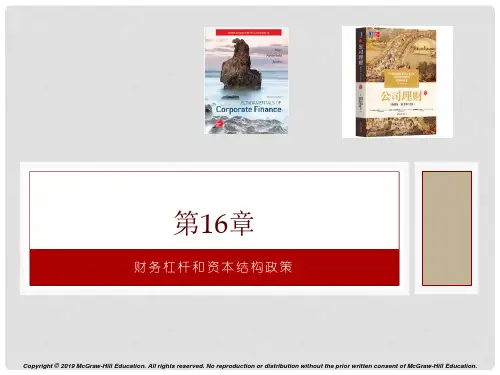
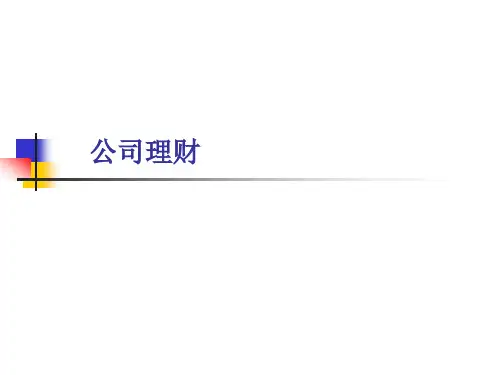
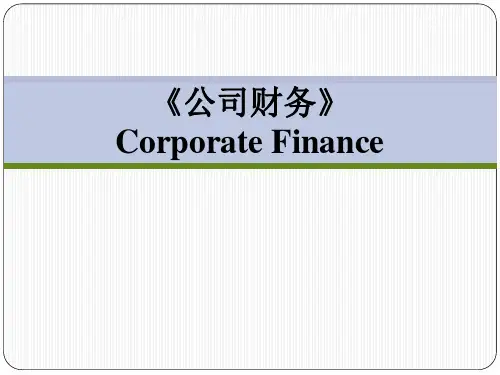
公司理财(精要版)(原书第6版)Fundamentals of Corporate Finance(6th edition)斯蒂芬A. 罗斯(Stephen A. Ross )(麻省理工学院)伦道夫W. 威斯特菲尔德(Randolph W. Westerfield )(南加利福尼亚大学)布拉德福德D. 乔丹(Bradford D. Jordan )(肯塔基大学)方红星译(美)著斯蒂芬A. 罗斯(Stephen A. Ross )现任麻省理工学院(MIT )斯隆管理学院(Sloan School ofManagement )弗朗科·莫迪格利安尼(Franco Modigliani )财务与经济学教授,在此之前任耶鲁大学商学院经济学与财务学教授,是世界上著述最丰的财务学家和经济学家之一。
罗斯教授以其在“套利定价理论”(APT )方面的杰出成果而闻名于世,并且在信号理论、代理理论、期权定价以及利率的期间结构理论等领域有深厚造诣。
他曾任美国财务学会会长,现任多家学术和实践类杂志副主编,加州教师退休基金会(CalTech )托管人,大学退休权益基金会(CREF )及Freddie Mac 公司董事,罗尔-罗斯资产管理公司董事会主席。
伦道夫W. 威斯特菲尔德(Randolph W. Westerfield )南加利福尼亚大学(USC )马歇尔商学院(Marshall School ofBusiness )院长,罗伯特R. 朵克森(Robert R. Dockson )工商管理教席教授。
1988~1993年任该院财务与企业经济学系主任,财务学教授。
此前曾在宾夕法尼亚大学(UPenn )沃顿(Wharton )商学院任教长达20年,并担任财务学系主任,怀特(Rodney L. White )财务学研究中心高级副主任。
他的学术专长包括公司财务政策、投资管理与分析、兼并与收购以及股票市场价格行为等。
他还兼任健康管理协会(NYSE :HMA )、William Lyon 住宅公司(NYSE :WLS )、Lord 基金会、AACSB 国际等公司董事,曾任美国电报电话(AT&T )、美孚(Mobil )石油、太平洋企业等著名公司以及美国联邦政府、司法部、劳工部和加利福尼亚州顾问。